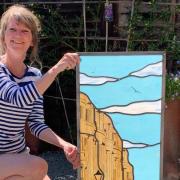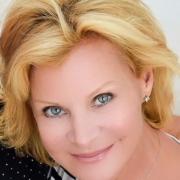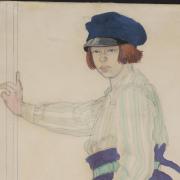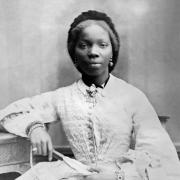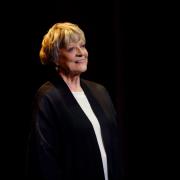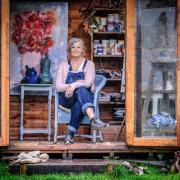She inspired the nation’s couch potatoes to get moving in the 1980s and 1990s as TV-am’s fitness guru, and Ferring’s Lizzie Webb is still keeping everyone on their toes today – thanks to her troubled childhood.
In the brave new world of 1980s breakfast television, two heavyweights of the fitness world were slugging it out to win the hearts and minds of a bleary-eyed nation. In the blue corner, on BBC Breakfast Time, was the Green Goddess (aka Diana Moran), a glamorous former catwalk model who, if nothing else, made sparkly lizard-green lycra leggings an unlikely fashion craze.
And in the red corner, at TV-am’s newly-launched Good Morning Britain, was ‘Mad Lizzie’, a dance instructor called Lizzie Webb, whose wild hair and balletic dance moves were eerily reminiscent of Kate Bush out on the heath in her pop video, Wuthering Heights.

Lizzie was as down to earth and accessible as Diana was ethereal; Rose Red to Diana’s Snow White, you might say. And she fizzed with energy. If anyone was going to put the snap, crackle and pop into your breakfast routine, it was Lizzie. In her twice-morning shake-outs, she had young mums, office workers and even recalcitrant school children shaking their stuff to funky dance beats before gobbling down their cereal and making a dash for the school bus.
Lizzie, who moved to Ferring, near Worthing, two years ago, is nearly 75 now, but all those decades of aerobic exercise have served her well. Her hair may be a few shades lighter, but she still looks youthful and has retained her enviably slim figure. But why the move to Sussex?
‘We were living near Henley-on-Thames in Oxfordshire, but I’d always wanted to live by the sea so downsizing to the South Coast seemed the obvious move,’ she says. ‘We’ve swapped a huge house for a newly-renovated chalet bungalow – and the sea is just at the end of the road.
‘My husband Douglas is a very good amateur golfer, so he has been enjoying playing at Worthing Golf Club, as well as for the county team. And I love walking by the sea at Littlehampton and exploring all the beautiful attractions in the area.’

We are chatting to mark the launch of Lizzie’s newly-published memoirs, Mad About the Boys. It’s not, as the title might suggest, a lurid account of her passion for younger men, but rather her life-long commitment to teaching dance to boys from disadvantaged backgrounds. It’s a pacy, well-written account of a career which has been as unflagging as her fitness workouts, and although it focuses on her life away from the spotlight there are plenty of showbiz insights, though she refrains from dishing the dirt on her breakfast TV co-stars.
Lizzie’s TV career happened entirely by chance when Greg Dyke was hired as editor-in-chief at the ailing TV-am. Dyke’s approach was unashamedly populist. Out went serious news; in came snappy segments lasting no longer than three minutes. Out went starchy old news presenters like Robert Kee and Anna Ford; in came the relatively unknown Nick Owen and Anne Diamond, backed by a chorus line which included a droll puppet called Roland Rat.
Dyke, however, needed one extra ingredient – a fitness expert who would give the BBC’s Green Goddess a run for her money. Thanks to Jane Fonda, aerobics was sweeping the nation, although he wanted someone very different to Moran. But who?

The first Lizzie knew of it was when a woman called Jane Tatnall sauntered up to her at the end of one of her dance classes at the Covent Garden Dance Centre. Tatnall had been attending Lizzie’s sessions for a while; she also happened to be Dyke’s PA. ‘I’ve told him you make exercise and dance fun – and you’re mad,’ she told a startled Lizzie. ‘Greg wants to meet you.’ But Lizzie had other ideas.
‘I’m a strange mixture of being confident in my work, but totally unsure of myself as a person,’ she says. ‘So I politely turned down the invitation, although Jane came back the next week and said that Greg was insistent that I should at least give him the courtesy of coming to see him.’ And, of course, that was that. Mad Lizzie was born.
Lizzie was thrown in at the deep end. ‘I was presenting live a week later,’ she gasps. ‘I’m not sure that would happen in TV now. When Nick Owen introduced my very first shake-out, nobody had thought to tell me where to stand or what the floor manager’s hand signals meant when he looked as though he was slitting his throat. No wonder I shook with nerves.’
To make matters worse, there was a distinct froideur in the TV-am studio. ‘On air we looked like a very happy family, but the camaraderie didn’t really exist in reality – well, not with me at least,’ she says, with uncharacteristic candour. Feeling like an outsider, she hid away in her dressing room.

Lizzie may have been quaking inside, but she soon got to work devising her own innovative approach to TV fitness, based on her extensive dance and teaching background. With just three minutes to make an impression, she devised easy-to-follow dance-based routines which catered for all ages and abilities. Where she feels she really scored, however, was in being given a completely free hand to choose her own clothes, music and content.
Ditching leotards and leggings for brightly-coloured jumpers, sparkly T-shirts and casual trousers, she implored the nation’s couch potatoes to wiggle their stuff no matter what they were wearing; to work fitness into their daily routine.
She quickly built up a loyal following, viewers responding to her warmth and endlessly imaginative dance routines. But she was innocently unaware of all this until Sir David Frost stopped to congratulate her. ‘I was amazed to discover that the latest polling figures had shown I was the most popular presenter on the network,’ she says.
Emboldened by the public confidence vote, Lizzie redoubled her efforts, introducing a weekly theme to link her exercise sessions. Everyone from sports and panto stars to policemen and firemen sweated it out on her exercise mat.
Household names took part in her shake outs, too. Thanks to the wonders of YouTube, we can all travel back to 1986 and grimace at Jeffrey Archer’s floundering attempts to mirror Lizzie’s graceful dance moves – not that it appeared to worry him in the slightest. Instead, he rebuked her for choosing a slow-tempo dance track. And when Lizzie announced that she was exercising with Miss UK the following day, he gallantly quipped, ‘Picked the wrong day, didn’t I?’
‘It surprised me that people like Jeffrey, with no obvious coordination, would come on, knowing that they were making themselves quite vulnerable,’ she says. ‘But if they were supporting a charity, they would put themselves in the firing line.’
Lizzie was at TV-am for a decade, but in 1992 the network lost its franchise and was outbid by GMTV. The new station wanted new faces and Lizzie was replaced by page three pin-up Linda Lusardi. How did she feel about being replaced by a glamour model?

‘I’m not sure what her background was in teaching,’ she says without rancour. ‘It takes more than looking gorgeous to do a slot like that.’ Tellingly, perhaps, Lusardi didn’t last long. In fact, no one has equalled Lizzie’s tenure as a TV fitness instructor.
Lizzie’s tenacity was forged during her difficult childhood in Barnet, north London. She never felt as clever as her two older sisters, mainly because she failed her Eleven Plus. ‘I lost confidence in learning and in myself,’ she says.
But there were also darker forces at play because her father, ‘a terrifying and controlling figure’, ‘thrashed her uncontrollably for typical childish transgressions’. She coped by locking the trauma away; she also found escape in the arts. Her mother held down several jobs to ensure Lizzie and her sisters had the weekly ballet lessons she had been denied as a child.
Lizzie also won a junior scholarship to the Guildhall School of Music and Drama, where she played violin, and gained a coveted place at the National Youth Theatre. Best of all, her mother worked flat out to send her to a private stage school.
When Lizzie graduated from teacher training college, she asked the Inner London Education Authority to give her the most challenging school they could find. She was sent to a boys’ comprehensive on Clapham Common, where she started a drama and dance club. From that school, one boy went on to become a member of Hot Gossip with Arlene Phillips, another became the first black dancer in the English National Ballet and a third became a theatre director in the West End.
‘If my father hadn’t treated me the way he had, I might never have felt so driven to help other vulnerable young people,’ she says. ‘I’ve never forgotten that feeling of fear, pain and injustice. I also feel very blessed for the opportunities I was given in the arts and have tried to offer the same.’
On moving to West Sussex, Lizzie had planned a well-earned retirement but her plans soon went awry. ‘People in Ferring asked if I would start a dance class, so now I’m running regular sessions at my local church hall and having a wonderful time,’ she smiles.
Now in her eighth decade, does she feel fit enough for the challenge? ‘I’m very lucky, touch wood,’ she says. ‘I didn’t realise just how lucky until I went to my local surgery for a jab and my GP was amazed to discover I wasn’t taking any medication. “Do you realise how unusual that is at your age?” she said. It’s something I’d never thought about. How lucky am I?’
Mad About the Boys: Fame, Fitness and Teaching London’s Toughest Kids by Lizzie Web is out now (Whitefox Publishing, £20).






